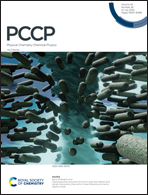Environmental effects on the singlet fission phenomenon: a model Hamiltonian-based study
Abstract
In the screening of compounds for singlet fission, the relative energies of the constitutive units are decisive to fulfil the thermodynamic rules. From a model Hamiltonian constructed on the local spin states of an active chromophore and its environment, it is suggested that embedding greatly influences the energy differences of the active monomer spin states. Even in the absence of charge transfer, the field generated by a singlet environment produces an increase of the [E(S1) − E(S0)]/[E(T1) − E(S0)] critical ratio by up to 6% as compared to the one of a free chromophore. Besides, variations are observed when the intimate electronic structure of the singlet environment is modified. This propensity towards singlet fission is even more pronounced (10%) when the environment is switched to the triplet state. Finally, the embedding is likely to reverse the spin state ordering in the limit of vanishing atomic orbital overlaps. Despite its simplicity, the model stresses the importance of the environment spin nature in the quest for singlet fission candidates, and more generally in spectroscopy analysis.



 Please wait while we load your content...
Please wait while we load your content...